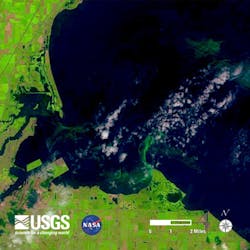The National Oceanic and Atmospheric Administration (NOAA) joined with NASA, the U.S. Environmental Protection Agency (EPA) and U.S. Geological Survey (USGS) to transform satellite data designed to probe ocean biology into information that will help protect the American public from harmful freshwater algal blooms.
The new $3.6 million research multi-agency effort is designed to be an early warning system for toxic and nuisance algal blooms in freshwater systems by using satellites that can gather color data from freshwater bodies during scans of the Earth. Based off this information, state and local agencies can provide the public with public health advisories. In addition, the project will improve the understanding of the environmental causes and health effects of these cyanobacteria and phytoplankton blooms in the U.S.
“Observing harmful algae is critical to understanding, managing and forecasting these blooms,” said Holly Bamford, Ph.D., acting assistant secretary of commerce for conservation and management, and deputy NOAA administrator. “This collaboration will assure that NOAA’s efforts will assist the coastal and inland public health officials and managers across the country to distribute this information to the community in an easily understandable fashion, making them more resilient to environmental events.”
The annual cost of U.S. freshwater degraded by harmful algal blooms is estimated to be $64 million in additional drinking water treatment, loss of recreational water usage and decline in waterfront real estate values. In August 2014, local officials in Toledo, Ohio, banned the use of drinking water supplied to more than 400,000 residents after it had been contaminated by an algal bloom in Lake Erie.
“EPA researchers are developing important scientific tools to help local communities respond quickly and efficiently to real-time water quality issues and protect drinking water for their residents,” said EPA Administrator Gina McCarthy. “Working with other federal agencies, we are leveraging our scientific expertise, technology and data to create a mobile app to help water quality managers make important decisions to reduce negative impacts related to harmful algal blooms, which have been increasingly affecting our water bodies due to climate change.”
“Harmful algal blooms have emerged as a significant public health and economic issue that requires extensive scientific investigation,” said Sarah Ryker, USGS deputy associate director for climate and land use change. “USGS uses converging lines of evidence from ground to space to assess changes in water quantity and quality, ecosystems, natural hazards, and environmental health issues important to the nation.”
The new network will build on previous NASA ocean satellite sensor technologies created to study the global ocean’s microscopic algal communities, which play a major role in ocean ecology, the movement of carbon dioxide between the atmosphere and ocean, and climate change. These sensors detect the color of the sunlit upper layer of the ocean and are used to create indicators that can help identify harmful algal blooms.
“The vantage point of space not only contributes to a better understanding of our home planet, it helps improve lives around the world,” said NASA Administrator Charles Bolden. “We’re excited to be putting NASA’s expertise in space and scientific exploration to work protecting public health and safety.”
NOAA and NASA have pioneered the use of this satellite data for monitoring and forecasting harmful algal blooms. Satellite data allows for more frequent observations over broader areas than water sampling. The data also supports NOAA’s existing harmful algae forecasting systems in the Gulf of Mexico and Great Lakes.
The first step in the five-year project will be creating a reliable, standard method for identifying cyanobacteria blooms in U.S. freshwater lakes and reservoirs using ocean color satellite data. Several satellite data sets will be evaluated and tested against environmental data from these water bodies.
Ocean color satellite data are currently accessible to scientists, but are not routinely processed and produced in formats that can meet the needs of state and local environmental and water quality managers. This project will convert the satellite data on cyanobacteria blooms developed by the four partner agencies to a format that the public can use through a mobile devices and Web portals.
The project also includes a research component to improve understanding of the environmental causes and health impacts of cyanobacteria and phytoplankton blooms across the U.S. Blooms in lakes and estuaries result from aquatic plants receiving excess nutrients from watershed runoff, as well as other environmental conditions such as temperature and light. Some land uses, such as urbanization or modernized agricultural practices, change the amount of nutrients and sediment delivered in watersheds, which can influence cyanobacterial growth.
Researchers will compare the new freshwater algal bloom satellite data with satellite records of land cover changes over time to look at which land-use activities may have caused environmental changes linked to the frequency and intensity of observed blooms. The results will help to develop better forecasts of bloom events.
Source: NOAA


